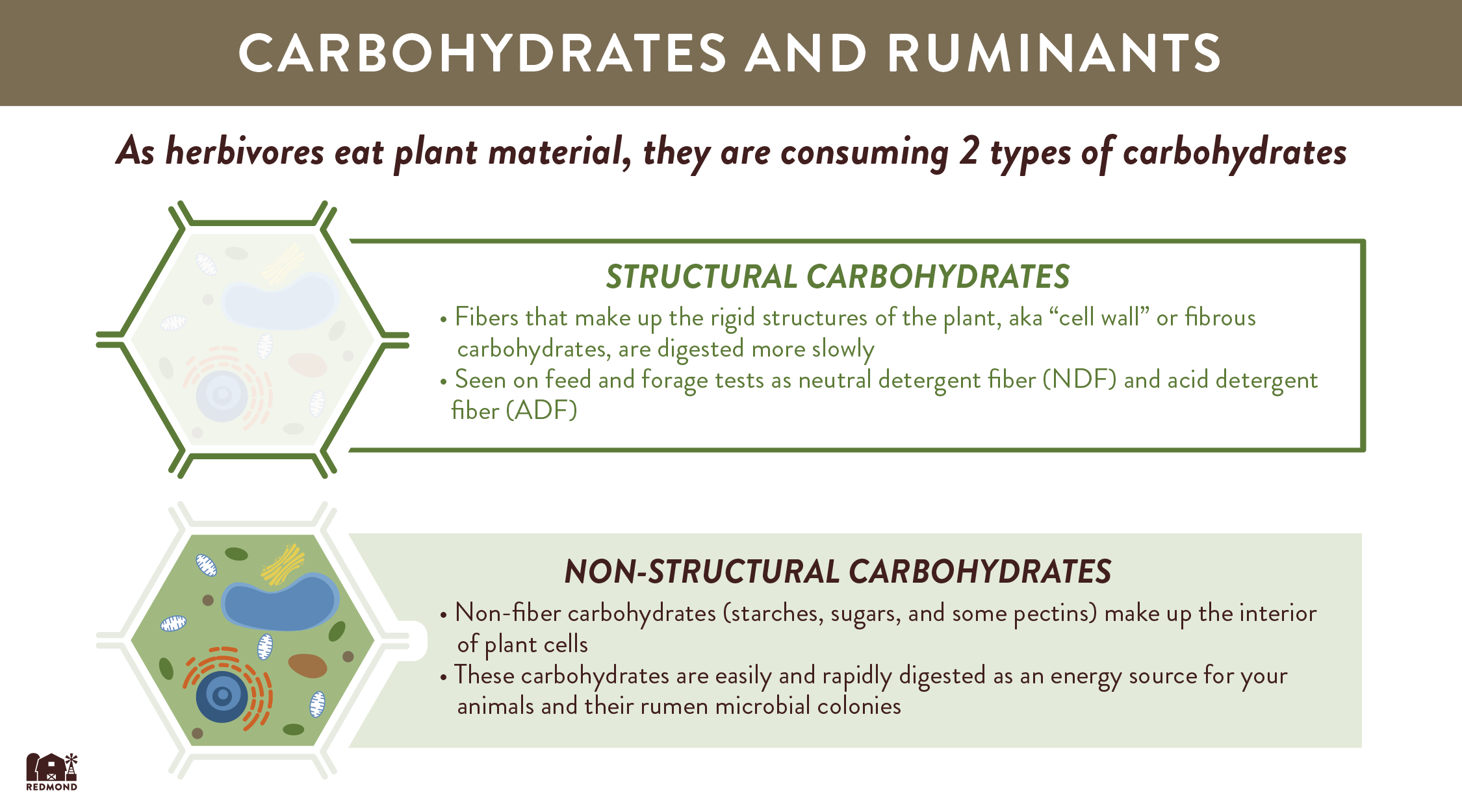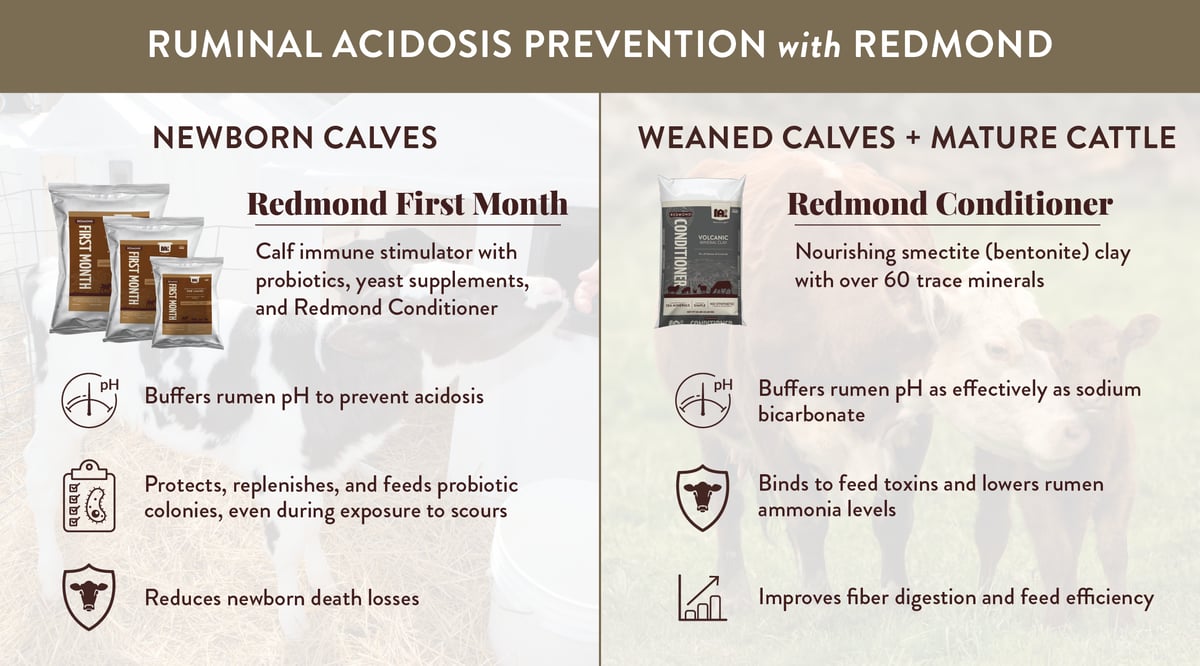Rumen acid-base balance has a major impact on livestock operations of all sizes. When pH levels are within healthy limits:
- Gut microbes reproduce and metabolize
- Fiber digestion and nutrient absorption increases
- Body condition scores improve and your ruminants thrive
When pH levels within the rumen drop and become more acidic, this digestive factory begins to shut down.
Ruminal Acidosis Risk Factors
There are many dietary, environmental, and other risk factors that can trigger ruminal acidosis.
Carbohydrate/Fiber Imbalance
The most common risk factor for acidosis is the imbalance of carbohydrate and fiber intake. This imbalance can result from:
- Eating too many rapidly digestible carbohydrates at the expense of fiber
- Errors in dry feed calculation
- Animals feeding in too tight quarters
- Feeding time schedule is rushed or inconsistent
- Sudden or drastic dietary changes
- Any cycles of feed deprivation followed by overeating
Heat Stress
- Elevated heart and respiratory rates decrease ruminal buffer capacity
- Heat avoidance and fatigue decrease meal frequency
Reproductive Stage
- Primiparous cows that are experiencing lactation diet for the first time
- Early lactation dietary changes affecting gut microbe levels
Stages of Acidosis
There are 2 stages or forms of ruminal acidosis: Subacute Ruminal Acidosis (SARA) and Acute Ruminal Acidosis (ARA). Let's look at the general definitions for each.

Subacute Ruminal Acidosis (SARA)
SARA is a milder and more correctable form of acidosis that sets in when rumen pH dips below ~5.8 for several hours a day. When too many quickly fermentable carbohydrates are eaten, volatile fatty acid (VFA) levels increase, creating a more acidic environment. This chain reaction causes a downward spiral of rising acidity and decreased microbe activity. With mild SARA cases, rumen buffers, dietary corrections, and attentive caregivers can successfully reverse the downward spiral.
Subacute Ruminal Acidosis Symptoms
- Reduced feed intake
- Reduced milk production and milk fat levels
- Poor body condition score, weight loss
- Unexplained diarrhea
- Body temperature changes
- Increased pulse and respiratory rate
- Lethargy/sluggishness
Acute Ruminal Acidosis (ARA)
ARA is the severe and deadly stage of acidosis when ruminal pH drops below ~5.5 for several hours. Identifying acidosis before ARA sets in is critical because even if an animal manages to recover from ARA, they will likely have future liver and other health complications.
Acute Ruminal Acidosis Symptoms
- Severe depression
- Staggering/stumbling
- Immobility/lameness
- Halted feeding/weight loss
- Severe diarrhea
- Liver abscesses
- Death
Acidosis Fixes and Treatments
Fortunately, many tried and true practices can help correct and prevent ruminal acidosis.
Change Carbohydrate/Fiber Intake
First, make some adjustments to feed and forage intake. When herbivores eat these plant based materials, they are consuming 2 types of carbohydrates:

- Structural carbohydrates- fiber rich carbohydrates that form the rigid structure of the plant (also known as "cell wall carbohydrates"). These substances are digested more slowly and show up on feed and forage tests as neutral detergent fiber (NDF) and acid detergent fiber (ADF).
- Nonstructural or nonfiber carbohydrates (NFC)- these non fiber substances (starches, sugars, some pectins) are found in the center of plant cells and ferment rapidly as quick energy for your animals and their gut microbes.
Both types of carbs are essential for your animals, but too many NFCs can tip the scales towards acidosis. Some feeds have higher NFC levels than others. Below is a ranking of feeds by average NFC levels from the Canadian Department of Agriculture:
- Corn- 75%
- Wheat- 65%
- Barley- 62%
- Corn silage (well eared)- 40%
- Beet pulp- 39%
- 47% Soybean meal- 34%
- Corn silage (few ears)- 29%
- Alfalfa (midbloom)- 24%
- Dried distillers grains- 16%
- Canola meal- 11%
It is also worth mentioning that grasses naturally have more structural carbohydrates and thus have higher fiber than grains. If possible, increasing access to forage (grazing or dried) can also help balance fiber vs. carbohydrate intake.
Use A Rumen Buffer
Saliva is a natural buffer for acid levels in the rumen, but modern livestock benefit from additional supplementation. Alkaline supplements can easily be added to feed rations both as a preventative and corrective measure for acidosis.

Did you know that Redmond Conditioner buffers just as efficiently as sodium bicarbonate? Plus the natural volcanic clay in our conditioner also improves feed efficiency and fiber digestion, controls ammonia levels, and binds to feed toxins. For weaned calves and mature cattle, Redmond Conditioner is the perfect solution for total rumen health for your herd.
- Want to see how these 2 rumen buffers measure up? See the bentonite vs. sodium bicarbonate study from West Virginia University.
Newborns need healthy rumen too! Redmond has taken the unique properties of our conditioner and formulated First Month, an immune stimulator for newborn ruminants. There are a lot of probiotic therapies out there, but only ours contains Redmond Conditioner which has been shown to reduce calf death losses by 63%. (Click article below to learn more about this study).
-
Learn how First Month works as a calf scours treatment
Reduce Heat Stress
Protecting your herd from excessive heat will help their feeding, grazing, watering, and resting patterns continue as normally as possible.
- Here are some best practices for reducing heat stress in your animals
Adjust Feeding Practices
According to the Merck Veterinary Manual, acidosis should be addressed at the herd level, and not individual animal basis. Here are some herd logistic adjustments that can help with acidosis:
- Watch for selective feeding- adjust the ratio of large and small particle sizes in your dry feed to prevent selective and picky eating
- Give your animals more space to feed to reduce feed competition
- Try providing smaller and more frequent meals
- Follow feed packaging instructions carefully (consult with your vet about any adjustments)
- Increase forage and/or transition to a feed with lower rapidly fermentable carbohydrates.
Redmond knows that when your animals feel good, you feel good. For over 50 years, our livestock mineral and conditioner program has helped operations all over the continent thrive. Contact us today at  to see how we can help you get back to what you love about raising animals!
to see how we can help you get back to what you love about raising animals!
